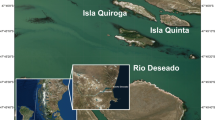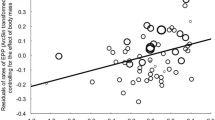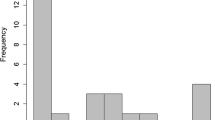Abstract
A potential cost of polygyny that may have restrained its evolution in some avian species is the presence of extra-pair offspring in the nests of males mated with several females. However, this relationship is not frequently found and an experimental approach investigating the association between extra-pair offspring and polygyny, while controlling for male traits related to polygyny, has not been undertaken. In this study, we manipulated the testosterone levels of facultatively polygynous spotless starlings, Sturnus unicolor, to establish experimentally different groups of polygyny and analyse its influence on levels of extra-pair offspring in males for which other traits were randomised. During two consecutive breeding seasons, we examined the effects of harem size on the ability of males to assure genetic paternity, assessed by DNA fingerprinting, and on reproductive success in their own nests. The frequency of extra-pair fertilisations varied between 10% (14/140) in 1996 and 20% (39/194) in 1997. Year-to-year analyses of extra-pair paternity variables with treatment as factor and harem size (number of simultaneous mated females) as covariate, were significant only in relation to harem size. Males with few simultaneously mated females were less cuckolded than more polygynous males in 1997 but not in 1996, indicating that mating costs of polygyny occurred, at least in the year with the higher rate of extra-pair paternity. Because polygynous males have more social mates, they may accrue higher reproductive success irrespective of their risk of being cuckolded. However, our results suggest that to be polygynous is costly in terms of paternity loss when we experimentally induce mating status controlling for individual male traits. However, the low values of our power tests for the statistically non-significant results of hormone on cuckoldry do not allow us to discard this hormone effect altogether.



Similar content being viewed by others
References
Birkhead TR, Møller AP (1992) Sperm competition in birds: evolutionary causes and consequences. Academic Press, London
Bollinger EK, Gavin TA (1991) Patterns of extra-pair fertilization in bobolinks. Behav Ecol Sociobiol 29:1-7
Burke T, Bruford MW (1987) DNA fingerprinting in birds. Nature 327:149–152
Burke T, Davies NB, Bruford MW, Hatchwell BJ (1989) Parental care and mating behaviour of polyandrous dunnocks Prunella modularis related to paternity by DNA fingerprinting. Nature 338:249–251
Davies NB (1989) Sexual conflict and the polygamy threshold. Anim Behav 38:226–234
Deceuninck B, Peris SJ, Calvo JM, Pascual JA, De la Cruz-Cardiel PJ (1997) Mate guarding in the spotless starling (Sturnus unicolor): timing and duration pattern in intermediate breeding pairs. Folia Zool 46:125–134
Dunn PO, Robertson RJ (1993) Extra-pair paternity in polygynous Tree Swallows. Anim Behav 45:231–239
Freeland JR, Hannon SJ, Dobush G, Boag PT (1995) Extra-pair paternity in willow ptarmigan broods: measuring costs of polygyny to mates. Behav Ecol Sociobiol 36:349–355
Freeman-Gallant CR (1997) Extra-pair paternity in monogamous and polygynous Savannah sparrows, Passerculus sandwichensis. Anim Behav 53:397–404
Gibbs HL, Weatherhead PJ, Boag PT, White BN, Tabak LM, Hoysak DY (1990) Realized reproductive success of polygynous red-winged blackbirds revealed by DNA markers. Science 250:1394–1397
Gowaty PA, Bridges WC (1991) Behavioral, demographic, and environmental correlates of extrapair fertilizations in eastern bluebirds, Sialia sialis. Behav Ecol 2:339–350
Gray EM (1997) Female red-winged blackbirds accrue material benefits from copulating with extra-pair males. Anim Behav 53:625–639
Hartley IR, Shepherd M, Robson T, Burke T (1993) Reproductive success of polygynous male corn bunting (Miliaria calandra) as confirmed by DNA fingerprinting. Behav Ecol 4:310–317
Hasselquist D, Bensch S (1991) Trade-off between mate guarding and mate attraction in the polygynous great reed warbler. Behav Ecol Sociobiol 28:187–193
Hasselquist D, Bensch S, von Schantz T (1995) Low frequency of extrapair paternity in the polygynous great reed warbler, Acrocephalus arundinaceus. Behav Ecol 6:27–38
Hegner RE, Wingfield JC (1987) Effects of experimental manipulation of testosterone levels on parental investment and breeding success in male house sparrows. Auk 104:462–469
Jeffreys AJ, Brookfield JFY, Semeonoff R (1985) Positive identification of an immigration test-case using human DNA fingerprintings. Nature 317:818–819
Kempenaers B, Geert R, Verheyen R, Dhondt A (1995) Mate guarding and copulation behaviour in monogamous and polygynous blue tits: do males follow a best-of-a-bad-job strategy?. Behav Ecol Sociobiol 36:33–42
Ketterson ED, Nolan V Jr, Wolf L, Ziegenfus C (1992) Testosterone and avian life histories: effects of experimentally elevated testosterone on behavior and correlates of fitness in the dark-eyed junco (Junco hyemalis). Am Nat 140:980–999
Lifjeld JT, Slagsvold T, Lampe HM (1991) Low frequency of extra-pair paternity in Pied Flycatchers revealed by DNA fingerprinting. Behav Ecol Sociobiol 29:95–101
Moreno J, Veiga JP, Cordero PJ, Minguez E (1999) Effects of paternal care on reproductive success in the polygynous spotless starling Sturnus unicolor. Behav Ecol Sociobiol 47:47–53
Raouf SA, Parker PG, Ketterson ED, Nolan V Jr, Ziegenfus C (1997) Testosterone affects reproductive success by influencing extra-pair fertilizations in male dark-eyed juncos (Aves: Junco hyemalis). Proc R Soc Lond B 264:1599–1603
Searcy WA (1981). Sexual selection and aggression in male Red-winged blackbirds. Anim Behav 29:958–960
Searcy WA, Yasukawa K (1995) Polygyny and sexual selection in Red-winged blackbirds. Princeton University Press, Princeton, N.J.
Smith HG, von Schantz T (1993) Extra-pair paternity in the European Starling: the effects of polygyny. Condor 95:1006–1015
Soukup SS, Thompson CF (1997) Social mating system affects the frequency of extra-pair patearnity in house wrens. Anim Behav 54:1089–1105
Trivers RL (1972) Parental investment and sexual selection. In: Campbell BF (ed) Sexual selection and the descent of man 1871–1971. Aldine, Chicago, pp 136–179
Veiga JP, Moreno J, Cordero PJ, Minguez E (2001) Territory size and polygyny in the spotless starling: resource-holding potential or social inertia? Can J Zool 79:1951–1956
Westneat DF (1993) Polygyny and extrapair fertilizations in eastern red-winged blackbirds (Agelaius phoeniceus). Behav Ecol 4:49–60
Westneat DF, Sherman PW, Morton ML (1990) The ecology and evolution of extra-pair copulations in birds. Curr Ornithol 7:331–369
Wetton JH, Carter RE, Parkin DT, Walters D (1987) Demographic study of a wild house sparrow population by DNA fingerprinting. Nature 327:147–149
Wetton JH, Parkin DT, Carter RE (1992) The use of genetic markers for parentage analysis in Passer domesticus (house sparrows). Heredity 69:243–254
Acknowledgments
This study has been funded by projects PB94-0070-C02–01 and PB97-1249 (DGICYT, Spanish Ministerio de Ciencia y Tecnología). We are grateful to Eduardo Minguez who assisted in field work in 1996 and to Luís M. Carrascal for valuable statistical support. Two anonymous referees, Tatiana Czeschlik and José M. Aparicio made helpful suggestions. The study was undertaken under licenses of the Spanish General Directorate for Nature Conservation and by the Regional Goverment of Madrid.
Author information
Authors and Affiliations
Corresponding author
Additional information
Communicated by M. Elgar
Rights and permissions
About this article
Cite this article
Cordero, P.J., Veiga, J.P., Moreno, J. et al. Extra-pair paternity in the facultatively polygynous spotless starling, Sturnus unicolor . Behav Ecol Sociobiol 54, 1–6 (2003). https://doi.org/10.1007/s00265-003-0603-6
Received:
Revised:
Accepted:
Published:
Issue Date:
DOI: https://doi.org/10.1007/s00265-003-0603-6




